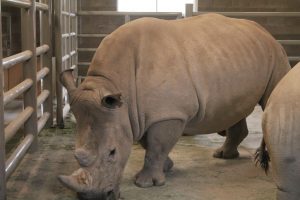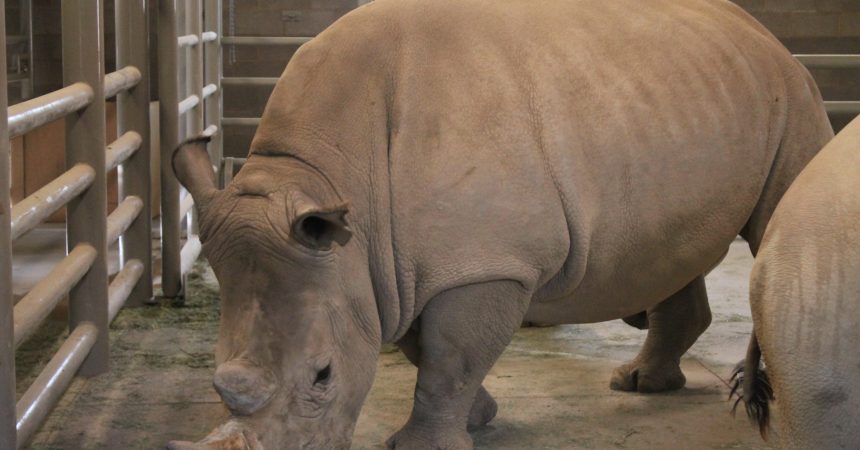Zoo InternQuest is a seven-week career exploration program for San Diego County high school juniors and seniors. Students have the unique opportunity to meet professionals working for the San Diego Zoo, Safari Park, and Institute for Conservation Research, learn about their jobs and then blog about their experience online. Follow their adventures here on the Zoo’s website!
 Jurassic Park – it was a revolutionary movie that pushed the boundaries of filmography and science fiction. The main premise of being able to bring a species back from extinction is mind-boggling, to say the least, but is it so far out of the realm of possibility? Not according to San Diego Zoo Global. I should be clear – there are absolutely no dinosaur projects on the Zoo’s agenda. What is in the works, though, is an incredible effort that holds great promise for conservation: saving the northern white rhino.
Jurassic Park – it was a revolutionary movie that pushed the boundaries of filmography and science fiction. The main premise of being able to bring a species back from extinction is mind-boggling, to say the least, but is it so far out of the realm of possibility? Not according to San Diego Zoo Global. I should be clear – there are absolutely no dinosaur projects on the Zoo’s agenda. What is in the works, though, is an incredible effort that holds great promise for conservation: saving the northern white rhino.
Last Thursday, my fellow interns and I had the privilege of touring the one-of-a-kind Rhino Rescue Center (RRC) at the Safari Park. There, we met with senior keeper Weston Peopichek, who gave us an inside view of the work it takes to a bring a species back from the brink of extinction.
Northern white rhinos have been endangered for decades, but in recent years, the situation has grown even more dire. Poaching has absolutely decimated the species. Currently, there are only three northern white rhinos in the world, all of whom are related and past reproductive age. In the past, this would lead to only one conclusion: this species would soon become extinct and its ecosystems would be forever lacking vital members. However, the dedicated team at the RRC is committed to changing this story. At the RRC, new hope is created every day for the northern white rhino through the help of a very special relative – the southern white rhino.
Like the northern white rhino, the southern white has also suffered great losses from human carelessness, most notably poaching. However, the southern white rhino’s population is significantly more stable at around 20,000 individuals. At this point, the question you’re probably asking yourself is, “How can one species of rhino help to save another?” The answer to this incredibly complex question lies in a concept that’s actually quite familiar for most people – surrogacy.
Think about how surrogacy works for humans. The egg and sperm of a couple who is unable to have children are joined to create an embryo, which is then implanted into a surrogate mother who carries the pregnancy for the couple, resulting in a child that is the genetic offspring of the couple. The same general principle applies when it comes to producing a northern white rhino calf with the help of a southern white rhino surrogate. The genetic material from a male and female northern white rhino is combined to create an embryo that will then be carried to term by a southern white rhino mother. With all three of the remaining northern white rhinos past reproductive age and living thousands of miles away in Kenya, though, science must be called upon once more. Incredibly, all the genetic material needed to create a northern white rhino is right here in San Diego. Where, you ask? In the Frozen Zoo! While its name might evoke images of polar bears and penguins, the Frozen Zoo is actually the oldest and largest collection of frozen animal samples. These samples include skin cells, tissue cells, and, most pertinent to the RRC’s work, stem cells. What’s significant about stem cells is that with the right technology, reproductive cells (sperm and eggs) can be generated from them. The Frozen Zoo contains genetic material from twelve northern white rhinos, with the hope being that soon, a northern white rhino can be born using this material. First, though, comes the years of work already begun by the RRC to prepare their six potential southern white surrogates for the monumental task ahead. It must be determined that these potential mothers are in tip-top shape to be able to carry a surrogate calf to term.
These six females – who also live with one male – began their journey at the RRC in December of 2015. Coming from a private reserve in South Africa, these rhinos had very little training experience before arriving in San Diego. Though there were many challenges ahead, senior keeper Weston Peopichek and the other four full-time keepers at the RRC remained undaunted. Through years of gradual training, acclimation to human touch and the regime of weekly medical tests, and plenty of tasty rewards, the RRC’s team has developed a deep trust with their rhino residents. The keepers are constantly devising new ways to mentally stimulate the rhinos through enrichment and prepare them for the possibility of surrogate motherhood in the future.
The future for northern white rhinos is still greatly at risk. However, the odds have never been better that this essential species could become the greatest comeback story our world has ever seen. With technological advancements, the help of southern white rhinos, and the care and compassion of the many people at the RRC and beyond who are giving all they can to save this species, hope is undeniable. So stay tuned – you might just see a new baby northern white rhino calf trotting around in the next decade!
Allison, Real World Team
Week Four, Spring Session 2018


